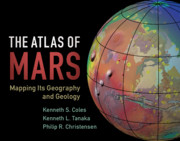Book contents
- The Atlas of Mars
- Additional material
- The Atlas of Mars
- Copyright page
- Table of Contents
- Preface
- Acknowledgments
- Abbreviations
- How to Use this Atlas
- Sources of Images
- Chapter 1 Introduction
- Chapter 2 History of Exploration of Mars
- Chapter 3 Global Character of Mars
- Chapter 4 Regional Geographic Features and Surface Views of Mars
- Chapter 5 Geology of Mars
- Map Sheets
- Mare Boreum (MC-1)
- Diacria (MC-2)
- Arcadia (MC-3)
- Mare Acidalium (MC-4)
- Ismenius Lacus (MC-5)
- Casius (MC-6)
- Cebrenia (MC-7)
- Amazonis (MC-8)
- Tharsis (MC-9)
- Lunae Palus (MC-10)
- Oxia Palus (MC-11)
- Arabia (MC-12)
- Syrtis Major (MC-13)
- Amenthes (MC-14)
- Elysium (MC-15)
- Memnonia (MC-16)
- Phoenicis Lacus (MC-17)
- Coprates (MC-18)
- Margaritifer Sinus (MC-19)
- Sinus Sabaeus (MC-20)
- Iapygia (MC-21)
- Mare Tyrrhenum (MC-22)
- Aeolis (MC-23)
- Phaethontis (MC-24)
- Thaumasia (MC-25)
- Argyre (MC-26)
- Noachis (MC-27)
- Hellas (MC-28)
- Eridania (MC-29)
- Mare Australe (MC-30)
- Moons: Phobos and Deimos
- Appendix
- Gazetteer
- References
- Index
Hellas (MC-28)
from Map Sheets
Published online by Cambridge University Press: 16 August 2019
- The Atlas of Mars
- Additional material
- The Atlas of Mars
- Copyright page
- Table of Contents
- Preface
- Acknowledgments
- Abbreviations
- How to Use this Atlas
- Sources of Images
- Chapter 1 Introduction
- Chapter 2 History of Exploration of Mars
- Chapter 3 Global Character of Mars
- Chapter 4 Regional Geographic Features and Surface Views of Mars
- Chapter 5 Geology of Mars
- Map Sheets
- Mare Boreum (MC-1)
- Diacria (MC-2)
- Arcadia (MC-3)
- Mare Acidalium (MC-4)
- Ismenius Lacus (MC-5)
- Casius (MC-6)
- Cebrenia (MC-7)
- Amazonis (MC-8)
- Tharsis (MC-9)
- Lunae Palus (MC-10)
- Oxia Palus (MC-11)
- Arabia (MC-12)
- Syrtis Major (MC-13)
- Amenthes (MC-14)
- Elysium (MC-15)
- Memnonia (MC-16)
- Phoenicis Lacus (MC-17)
- Coprates (MC-18)
- Margaritifer Sinus (MC-19)
- Sinus Sabaeus (MC-20)
- Iapygia (MC-21)
- Mare Tyrrhenum (MC-22)
- Aeolis (MC-23)
- Phaethontis (MC-24)
- Thaumasia (MC-25)
- Argyre (MC-26)
- Noachis (MC-27)
- Hellas (MC-28)
- Eridania (MC-29)
- Mare Australe (MC-30)
- Moons: Phobos and Deimos
- Appendix
- Gazetteer
- References
- Index
Summary
Hellas basin occupies the northwestern part of the quadrangle and makes up the deepest depression on Mars and the largest, well-preserved impact structure, at ~2,300 km inner diameter. The basin floor, Hellas Planitia, is largely a hummocky plain, marked by a network of wrinkle ridges and patches of knobby and troughed terrains, including Hellas Chaos. The lowest elevation on the planet (–8,200 m) occurs within the 33-km-diameter Badwater crater in the northwest corner of the quadrangle in Hellas Planitia. The basin rim is partly dominated by plains and low shield structures to the south (Malea Planum and Amphitrites Patera) and northeast (the southern edge of Hesperia Planum in MC-22, and Hadriacus Mons). The plains lie at 0–3 km elevation. Slopes north of Malea Planum are furrowed by dense, shallow valley systems (including Axius and Mad Valles), whereas the northeastern slope is deeply dissected by Dao, Niger, Harmakhis, and Reull Valles. Except for Reull, these valleys have sinuous, trough-like rille forms, which narrow in the downstream direction. The Promethei Terra highlands, east of Hellas basin rim, are characterized by particularly rugged terrain, including high-standing massifs and deep crater forms.
Information
- Type
- Chapter
- Information
- The Atlas of MarsMapping its Geography and Geology, pp. 222 - 227Publisher: Cambridge University PressPrint publication year: 2019
